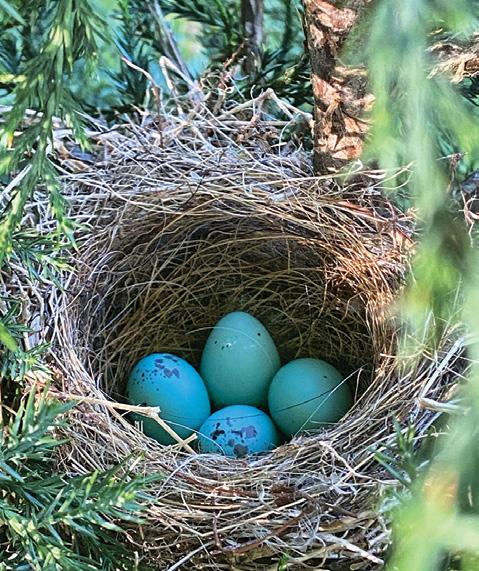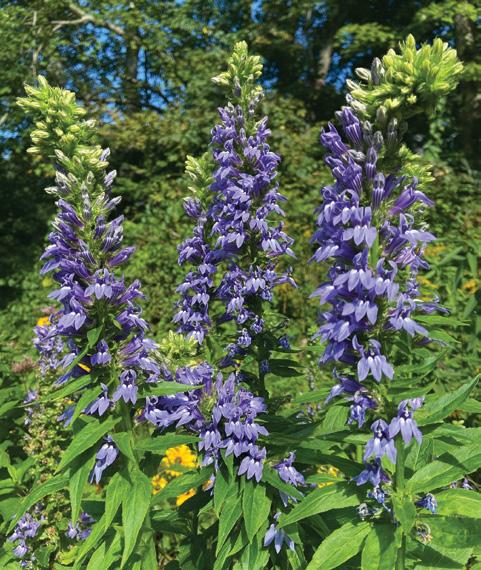
4 minute read
HOLISTIC WELLNESS THROUGH RESTORATIVE LAND CARE
HOLISTIC WELLNESS
through Restorative Land Care
Advertisement
by Brittney Hawthorne and Michael Baczewski
We have the power to profoundly influence the health of our planet, our communities, our families, and ourselves—and it begins right in our own backyard.
How did our yards become so unhealthy?
When you purchase or rent a property, you inherit the land care decision of the previous owners. Spanning over a century, the fixation to attain the “perfect lawn” and “ideal yard” has led generation after generation to make harmful land care decisions that not only place local ecosystems in peril but the health of future generations as well. Treated with toxic chemicals, depleting vital resources and lacking biodiversity, the average American yard is unhealthy, and it is impairing our health and wellness too.
Widespread Use of Toxic Chemicals
Insecticides, synthetic fertilizers and pesticides have detrimental ecological and human health implications. Pesticides alone have been documented to infiltrate ground water and pollute waterways— what is more startling is that they are still readily used today in the modern landscape. In fact, Americans use more than one billion pounds of pesticides per year. In 2018, Cornell’s College of Human Ecology researchers Joseph Laquatra, Mark Pierce, Alan Hedge and Ann Lemley examined the extent of indoor pesticide pollution in 350 New York homes. They found all 350 homes tested positive for pesticide residue. “Numerous health problems occur from exposure to pesticides, such as cancer, birth defects, leukemia and ocular toxicity, among a number of other health issues. Households with crawling toddlers should be concerned, as toddlers will accumulate pesticide residues on their hands and then ingest them due to hand-to-mouth behaviors,” the authors concluded. Furthermore, pesticide residues are tracked into homes by shoes, bare feet, clothing, animal fur and even through airborne entry; once inside a home, pesticide residues can remain present for years.
The Societal and Ecological Impact of Excessive Maintenance Inputs
As our collective well-being and public health becomes challenged by droughts, flooding, wildfires and unpredictable weather patterns shaped by climate
change, our earth resources deserve to be stewarded responsibly. NASA estimates there to be nearly 31,360,000 acres of conventional lawn in America. Now think of the amount of fossil fuel required to mow or the amount of water required to maintain that acreage annually? You can be the judge if maintaining the American lawn is worthy of the carbon footprint it produces or if the amount of water it consumes each year is sustainable.
The Problem with Too Much Lawn
“We are at a critical point of losing so many species from local ecosystems that their ability to produce oxygen, clean water, flood control, pollination, pest control, carbon storage, etc.—that is, the ecosystem services that sustain us—will become seriously compromised,” notes University of Delaware professor and author Doug Tallamy of this dire American moment when conventional lawn is void of the ability to sustain or enhance the biodiversity required to support all livings things. While a confluence of poor land care decisions has transcended generations and consequently, left our landscapes polluted and holistic well-being challenged, there exists an opportunity to help Mother Nature heal and to create healthy, more sustainable and more biodiverse landscapes.

The Restorative Land Care Movement
Through ecological based design, and the use of organic land care practices for Mother Nature, our families, our communities and for ourselves, our influence can be restorative.

Restorative land care is rooted out of the several key principles.
n The Principle of Health: Our work sustains and enhances the health of soil, plants, animals, humans and our planet. n The Principle of Ecology: Our work sustains and emulates living ecological systems and cycles. n The Principle of Fairness: Our work builds relationships characterized by shared values and stewardship of a shared world. n The Principle of Care: Our work fosters the health and well-being of current and future generations and the environment.
Restorative land care steps that we can take this year to help Mother Nature thrive and, in turn, help all of us thrive include:
1. avoid using pesticides, insecticides, synthetic fertilizers and other toxic chemicals;
2. reduce or eliminate unnecessary inputs such as daily watering or costly mulch;
3. reduce the overall square footage of lawn and restore it back to a flourishing natural habitat through the introduction of neonicotinoid-free native trees, shrubs and perennials;
4. remove invasive plant species that harm ecological vibrancy; 5. purchase or, even better, grow diverse selection of neonicotinoid-free native plants;
6. inform and educate family, friends, neighbors and community about the importance of taking these restorative land care steps; and
7. support small businesses like local native plant nurseries to reduce the overall carbon footprint of product supply chains.

Citations and Helpful Resources
Northeast Organic Farming Association (CTNOFA.org) Wild Ones (WildOnes.org) Ecological Landscape Alliance (EcoLandscaping.org) Homegrown National Park (HomegrownNationalPark.com)
Brittney Hawthorne and Michael Baczewski, AOLCP, founded New England Pollinator Gardens, a full service ecologicalbased design and restorative land care company serving clientele throughout New England. The company focuses on strategic and sustainable sourcing practices. Their professional certification and affiliations include NOFA Organic Land Care Program, WildOnes, Ecological Landscape Alliance and Doug Tallamy’s Homegrown National Park. Connect at NewEnglandPollinatorGardens.com or Instagram @newenglandpollinatorgardens.






